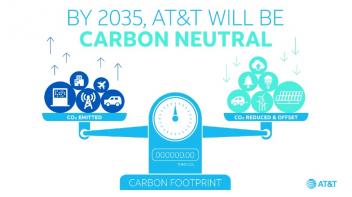AT&T has committed to be carbon neutral across its entire global operations by 2035. The company is also expanding its Climate Change Analysis Tool (CCAT) across the contiguous United States to identify the potential impacts of climate change on the network and operations – up to 30 years into the future.
The company will achieve net zero Scope 1 and 2 emissionsi – the yearly equivalent of 1,104,036 homes’ electricity useii – by focusing on six key initiatives:
Virtualization of many network functions: AT&T will be eliminating significant portions of energy-intense network equipment and rely instead on low-cost, energy-efficient hardware that can virtualize the functions of the network equipment. As a result, the company will be able to deploy new capabilities faster, utilize less energy and lower its greenhouse gas emissions footprint. The company currently has 75% of its core network functions virtualized.
Transitioning to a low-emissions fleet: AT&T will continue to bring down emissions from its operational fleet by optimizing routes, switching to hybrid vehicles and reducing the overall size of the fleet. The company is also planning for the decarbonization of its fleet.
Accelerating energy efficiency and network optimization efforts: Each year, AT&T implements thousands of energy efficiency projects across its network and operations, bringing down electricity use and reducing costs.
Expanding sustainable feature film and TV production: WarnerMedia reduces the energy and resource consumption associated with film and television production through cleantech solutions, sustainable products, and reuse and waste reduction efforts.
Supporting the renewable energy marketplace: By entering into power purchase agreements with renewable energy developers, AT&T reduces its emissions footprint, hedges against rising energy costs and helps to add more clean electricity to the U.S. power grid.
Investing in carbon offsets: Though AT&T aims to reduce its footprint to as close to zero emissions as possible, there may be some sources of emissions that cannot be eliminated. In these cases, the company will invest in carbon offsets to cover the associated emissions.
While striving for carbon neutrality, AT&T knows it also needs to continue its path of adaptation and resilience. Thus, the company is expanding its industry-leading Climate Change Analysis Tool (CCAT) from four pilot states in the Southeast to the entire contiguous U.S. to identify the potential impacts of climate change on its network and operations – up to 30 years into the future. Climate impacts will include flooding and hurricanes, as well as drought and wildfire projections across the U.S.
Over the past 5 years (2015-2019), AT&T invested more than $135 billion in its wireless and wireline networks, including capital investments and acquisition of wireless spectrum and operations. Over this same period, AT&T invested more in the United States than any other public company. AT&T has spent about $1 billion recovering from climate-related severe weather events since 2016. With the expansion and implementation of CCAT, AT&T can better ensure the resilience of its infrastructure.
“Our network is tested by climate change and natural disasters every year,” said John Stankey, AT&T chief executive officer. “We recognize the long-term impact these commitments can have, and we owe it to the millions of customers who rely on our services to create the most resilient and sustainable business we can.”
A CCAT pilot, supported by climate change projections from the U.S. Department of Energy’s Argonne National Laboratory, launched in 2019 and focused on the regional climate impacts in the Southeast such as hurricanes and flooding. For example, AT&T can cross-reference its fiber cable locations with projected sea-level rise in the year 2050 to understand where to harden its existing infrastructure and to better plan for future builds with resilience top of mind.
Last year, the company launched the AT&T Climate Resiliency Community Challenge for universities to collaborate with local governments in the Southeast to conduct climate risk analysis using the data developed by Argonne National Laboratory and shared by AT&T. AT&T provided $250,000 to assess climate risks and help boost community resilience in 5 geographies. University and community recipients were Appalachian State University (Boone, NC), Georgia Institute of Technology (Atlanta, GA), University of Georgia (Athens, GA), University of Miami (Miami, FL) and University of South Florida (St. Petersburg, FL).
As with the pilot, AT&T will make the climate modeling data calculated by Argonne National Laboratory for AT&T available to the public, including universities, municipalities and others, to use in their own climate risk analysis.
Source: https://about.att.com/story/2020/att_carbon_neutral.html

